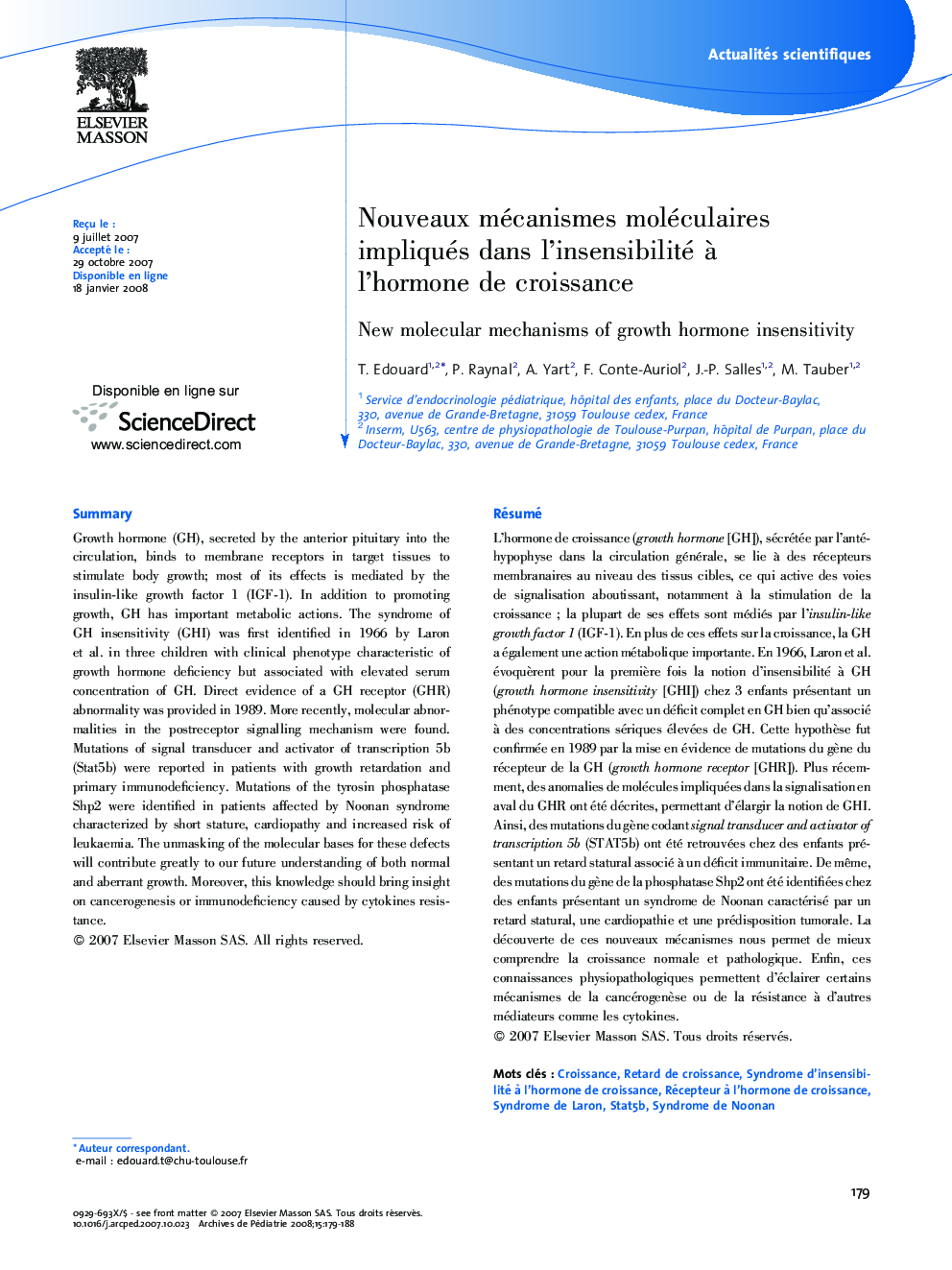| کد مقاله | کد نشریه | سال انتشار | مقاله انگلیسی | نسخه تمام متن |
|---|---|---|---|---|
| 4148648 | 1272710 | 2008 | 10 صفحه PDF | دانلود رایگان |

RésuméL’hormone de croissance (growth hormone [GH]), sécrétée par l’antéhypophyse dans la circulation générale, se lie à des récepteurs membranaires au niveau des tissus cibles, ce qui active des voies de signalisation aboutissant, notamment à la stimulation de la croissance ; la plupart de ses effets sont médiés par l’insulin-like growth factor 1 (IGF-1). En plus de ces effets sur la croissance, la GH a également une action métabolique importante. En 1966, Laron et al. évoquèrent pour la première fois la notion d’insensibilité à GH (growth hormone insensitivity [GHI]) chez 3 enfants présentant un phénotype compatible avec un déficit complet en GH bien qu’associé à des concentrations sériques élevées de GH. Cette hypothèse fut confirmée en 1989 par la mise en évidence de mutations du gène du récepteur de la GH (growth hormone receptor [GHR]). Plus récemment, des anomalies de molécules impliquées dans la signalisation en aval du GHR ont été décrites, permettant d’élargir la notion de GHI. Ainsi, des mutations du gène codant signal transducer and activator of transcription 5b (STAT5b) ont été retrouvées chez des enfants présentant un retard statural associé à un déficit immunitaire. De même, des mutations du gène de la phosphatase Shp2 ont été identifiées chez des enfants présentant un syndrome de Noonan caractérisé par un retard statural, une cardiopathie et une prédisposition tumorale. La découverte de ces nouveaux mécanismes nous permet de mieux comprendre la croissance normale et pathologique. Enfin, ces connaissances physiopathologiques permettent d’éclairer certains mécanismes de la cancérogenèse ou de la résistance à d’autres médiateurs comme les cytokines.
SummaryGrowth hormone (GH), secreted by the anterior pituitary into the circulation, binds to membrane receptors in target tissues to stimulate body growth; most of its effects is mediated by the insulin-like growth factor 1 (IGF-1). In addition to promoting growth, GH has important metabolic actions. The syndrome of GH insensitivity (GHI) was first identified in 1966 by Laron et al. in three children with clinical phenotype characteristic of growth hormone deficiency but associated with elevated serum concentration of GH. Direct evidence of a GH receptor (GHR) abnormality was provided in 1989. More recently, molecular abnormalities in the postreceptor signalling mechanism were found. Mutations of signal transducer and activator of transcription 5b (Stat5b) were reported in patients with growth retardation and primary immunodeficiency. Mutations of the tyrosin phosphatase Shp2 were identified in patients affected by Noonan syndrome characterized by short stature, cardiopathy and increased risk of leukaemia. The unmasking of the molecular bases for these defects will contribute greatly to our future understanding of both normal and aberrant growth. Moreover, this knowledge should bring insight on cancerogenesis or immunodeficiency caused by cytokines resistance.
Journal: Archives de Pédiatrie - Volume 15, Issue 2, February 2008, Pages 179–188